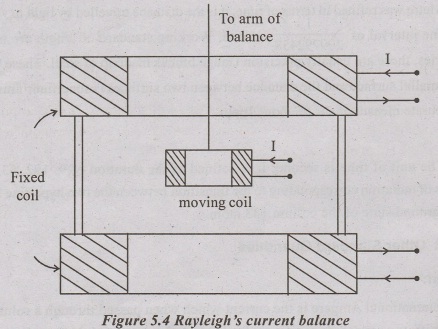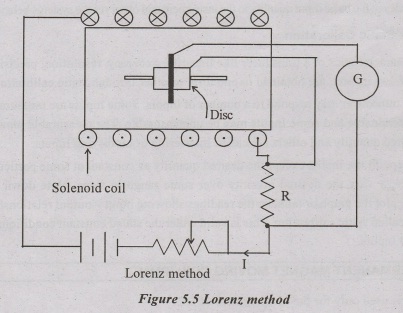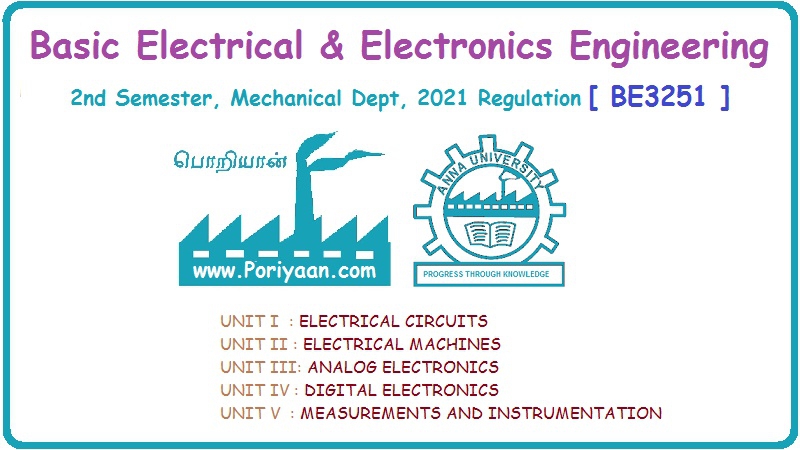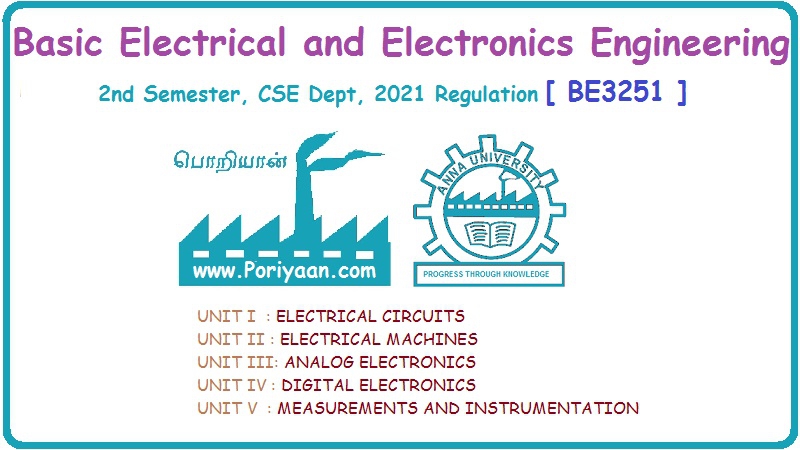Basic Electrical and Electronics Engineering: Unit V: Measurements and Instrumentation
Standards and Calibration
Measurements and Instrumentation
The standard is the physical representation of the unit, standard is applied to an instrument having a known measure of physical quantity.
STANDARDS
AND CALIBRATION
Standard
The
standard is the physical representation of the unit, standard is applied to an
instrument having a known measure of physical quantity. This instrument is used
for obtaining the physical properties of other instruments by comparison
methods.
Unit
is represented by a material standard or by reference to a natural phenomenon
including physical and atomic constants.
E.g.,
units of length in SI unit is Metre (m). It is defined as the Length equal to
1,650, 763. 73 wavelengths in vacuum of radiation corresponding to the
transition between the Level 210 and 5d5 (orange red
line) of krpton 86 atom (excited at the triple of nitrogen, 63.15 Kelvin).
According
to their functions and applications standards are classified into four types,
they are:
1. International Standards:
It
is maintained at the International Bureau of weights and measures. These
standards represents the units which are closest to the possible accuracy
attainable with present technology. These standards are checked and evaluated
regularly against absolute measurements in terms of fundamental units. These
standards are not available to ordinary user for their Instruments calibration.
One of the main reason for using absolute unit is that it do not vary
appreciably with time.
2. Primary Standards:
Primary
standards are absolute standards of high accuracy and it is used as reference
standards. These standards are maintained by national standards laboratories in
different parts of the world.
These
standards represents all fundamental, supplementary and derived units
calibrated by absolute measurements at each national laboratories. These
standards are not available outside the national laboratories. Its main
function is the verification and calibration of secondary standards.
3. Secondary Standards:
These
are the reference standard used in industrial measurement laboratories. These
standards are checked Locally against reference standards available in that
area. These instruments are sent periodically to the national standard
laboratories for calibration and comparison against primary standard. They sent
back the instrument. with a certificate mentioning that the instrument is
calibrated against primary standards.
4. Working Standards:
Working
standards are available in the measurement laboratory. These are used for the
calibration of general Laboratory instruments.
Standard of Mass, Length and Time
Mass:
The
unit of mass is kilogramme, A kilogramme is equal to the mass of the
international prototype (a cylinder of platinum iridium alloy) of mass. The
primary standard of mass has an accuracy of part in 108 and verified
against the international standard. The secondary standard of mass has on
accuracy of 1 ppm and working standard has an accuracy of 5 ppm.
Length:
International
standard of Length is given by optical standard. The orange red radiation
emitted by krypton - 86 discharge lamp when excited forms the basic unit of
Length. This can be measured to an accuracy of 1ppm.
Metre
was refined in terms of time, it is the distance travelled by light in vacuum
in a time interval 1/299792458 of second. Working standard of length are wide
in industries, these are usually precision Gauge blocks madeup of steel. These
blocks have parallel surface and the distance between two surfaces is
specified. This gives the accurate measurement of about 1ppm.
Time:
The
unit of time is second, It is defined as the duration of 9, 192, 631, 770
periods of radiation corresponding to the transition between the two hyperfine
Levels of the ground state of the cesium 133 atom.
Other Standard Quantities
Current:
International
Ampere is the current which when passed through a solution of silver nitrate,
causes deposition of silver at the rate of 1.118 mg/sec. these International
ampere is superseded by absolute ampere, in 1948.
Absolute ampere:
It
involves the measurement of force because its dimension resembles the dimension
of force dimension of (current)2= [MLT-2]
The
force may be exerted by the current in a solenoid (as in tangent galvanometer)
or by the current flows through the two different parts of the circuit
connected in series. (current balance)
Rayleigh's current balance:
It
consists of two fixed coil and a small moving coil. These three coils are
connected in series. Moving coil is suspend from the arm of a sensitive balance
If a current flows through these coils, force will be exerted on the moving
coil and is given by F = I2 dm/dx
newton
Were,
dM/dx is the rate of change of mutual inductance between the fixed and
moving
coils.

In
SI unit absolute Ampere is the fundamental unit of current.
Voltage:
Standard
volt was given by electrochemical cell (saturated standard cell). But it has
the drawback of temperature dependence.
In
1962, Josephson developed a new standard for voltage, it is the voltage
developed across a thin film function which is cooled to nearly absolute zero
and irradiated with microwave. The voltage developed is related to irradiating
frequency by.
v
= hf /2e
Where
v is the voltage developed
h
is the plancks constant
ƒ
is the irradiating microwave frequency and e is the electron volt.
Resistance:
The
standard resistor is made up of some alloy like manganin, having high
electrical resistivity and low temperature coefficient.
Absolute
measurement of resistance is done by measuring the velocity or by measuring the
Length and time. It is done by Lorenz method.
In
this method, current flows through a solenoid producing flux lines, a disc is
placed inside the solenoid and tend to rotate. Due to the flow of current
through the resistor whose value is to be measured gives a voltage drop. Disc
also produces some amount of voltage due to its rotation in the flux path. The
Galvanometer reads zero when these two voltages are equal. It is given by
MIN
= IR
R
= Mn
Where
R is the resistance,
M
is the mutual inductance,
n
is the speed of the disc in rps.

Luminous intensity:
The
primary standard of luminous intensity is the black body or planking radiator
at the temperature of 2042k (solidification of platinum occur at this
temperature). Black body is called the full radiator.
Now
candela is 1/60 of Luminous intensity per square centimeter of full radiator.
Secondary standards are obtained from special tungsten filament lamps.
Calibration
Calibration
is defined as the process of determination of the correct value of each scale
reading on a meter or other measuring instrument by measurement or comparison
with a standard.
In
Laboratory, the calibration of instruments are it done by comparing the reading
of the instrument with the sub-standards at several points along the scale.
These sub - standards are periodically checked against some standards held
permanently in national laboratories. This type of calibration hold good for
mechanical measurements.
In
process measuring Instruments calibration is done by feeding the known
magnitudes of the basic input quantity to the instrument and observes the
systems behavior.
Static Calibration
Characteristics
of a transducer like linearity, Accuracy, resolution, precision, range and
span, etc., are obtained in one form or other through static calibration. A
transducer may respond to a number of inputs. Some Inputs are measurable and
determinable and some Inputs may be unmeasurable. The measurable input is the
desired quantity and others are called Interfering or modifying Inputs.
Kept
all the inputs except the desired quantity as constant at some particular
value, Now vary the desired quantity over some range in steps, Note down the
outputs, plot the graph or tabulate the readings showing input-output
relationship. This is called static calibration. This is valid under the stated
constant conditions of all other inputs.
Basic Electrical and Electronics Engineering: Unit V: Measurements and Instrumentation : Tag: : Measurements and Instrumentation - Standards and Calibration
Related Topics
Related Subjects
Basic Electrical and Electronics Engineering
BE3251 2nd semester Mechanical Dept | 2021 Regulation | 2nd Semester Mechanical Dept 2021 Regulation
Basic Electrical and Electronics Engineering
BE3251 2nd Semester CSE Dept 2021 | Regulation | 2nd Semester CSE Dept 2021 Regulation

